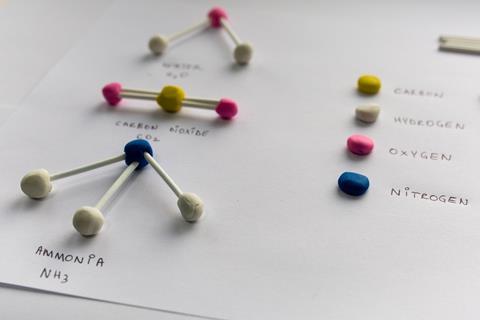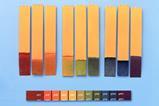Home-made models are not just cheaper, they can be more effective for learning
Much of what we know about chemistry cannot be seen. Instead, scientists have developed models to describe key concepts based on the available evidence and mathematical principles. Models can be considered thinking tools that help form explanations. They are also useful simplifications to aid understanding.

Physical modelling in the chemistry classroom is a good way to help students visualise concepts like molecular geometry, structure and bonding, atomic structure and collision theory. Although the theory of ‘learning styles’ in teaching and learning has been widely discredited, kinaesthetic approaches – learning activities that involve doing things – do add variety to lessons for teachers and students. Physical models may also stimulate discussion between students or facilitate discussion between student and teacher.
Molecular model kits are often used for physical modelling in the chemistry classroom. The atoms and connections in molecular model kits have been specifically designed to replicate the observed angles and valencies of atoms in covalent molecules. However, the kits can be expensive and restrict modelling activities to the school environment. Informal modelling using available materials provides an accessible alternative. One study that looked at informal modelling of molecular geometry found that do-it-yourself model kits using pipe cleaners appeared to be ‘more meaningful for the better students and to be more enjoyable for all’.
Molecular model kits are often used for physical modelling in the chemistry classroom. The atoms and connections in molecular model kits have been specifically designed to replicate the observed angles and valencies of atoms in covalent molecules. However, the kits can be expensive and restrict modelling activities to the school environment. Informal modelling using available materials provides an accessible alternative. One study that looked at informal modelling of molecular geometry found that do-it-yourself model kits using pipe cleaners appeared to be ‘more meaningful for the better students and to be more enjoyable for all’.1
Choosing modelling materials
You can find examples of chemistry concepts modelled using every imaginable material in the academic literature and elsewhere. Spheres to represent atoms can be modelled with craft materials like polystyrene balls, plasticine or sticky tack. Atom connections can be modelled with pipe cleaners, cotton buds or toothpicks. Put together, these are similar to models made with molecular model kits. Students need to decide how many connections to make and where to place them, which provides challenge for higher achievers. Scaffolding can support students needing extra help.

In your class
Download an activity worksheet to make a model of the bonding in ammonia as MS Powerpoint or pdf.
Bonding models can be made with similar materials. Cardboard jigsaw shapes or punched cards can represent ions. Pipe cleaners as valence shells and beads as outer electrons can illustrate the Lewis model of covalent bonding. String, cardboard circles or wire make electron shells for model atoms, while sticky dots, googly eyes, jewellery beads and even sweets can show the electrons.
Bonding models can be made with similar materials. Cardboard jigsaw shapes or punched cards can represent ions. Pipe cleaners as valence shells and beads as outer electrons can illustrate the Lewis model of covalent bonding.2 String, cardboard circles or wire make electron shells for model atoms, while sticky dots, googly eyes, jewellery beads and even sweets can show the electrons.
Getting the most out of physical models
Models are tricky for teachers to use because misconceptions can arise. For example, a common misconception is that a scientific model is a replica version of the real thing, in the same way that a die-cast toy car is a model of a standard sized vehicle. Few students understand why scientists use multiple models to explain concepts. Additionally, the word ‘model’ has multiple meanings depending on the context. When we use the word ‘model’ in teaching, what comes to our students’ minds is likely to be different to what is in our heads.
Models are tricky for teachers to use because misconceptions can arise. For example, a common misconception is that a scientific model is a replica version of the real thing, in the same way that a die-cast toy car is a model of a standard sized vehicle. Few students understand why scientists use multiple models to explain concepts.3 Additionally, the word ‘model’ has multiple meanings depending on the context. When we use the word ‘model’ in teaching, what comes to our students’ minds is likely to be different to what is in our heads.
As with any classroom activity you must evaluate the learning aims accompanying a modelling activity and plan other aspects of the lesson so students make progress. Freeform modelling lessons are rarely successful. Experiment with materials in advance of lessons to anticipate where misconceptions or even misbehaviour may arise. Consider which questions will probe students’ understanding and how questioning and thinking will work for large classes. For example, packs of question cards between pairs of students provide prompts for discussion. They allow the teacher to follow up at the end of the lesson with direct questioning once students have had a chance to think.
Beyond the lesson, informal models make good classroom displays, providing a lasting memory hook. Since they are inexpensive, students can take them home or use materials from home to make models and critique them.
We would love to see the informal modelling activities you do with your classes. Tweet us @RSC_EiC.

Top tips for informal modelling
1. Consider the logistics of distributing the materials and cleaning up.
2. Anticipate what issues could arise from using your chosen materials, eg hygiene issues for sweets in labs, and safety issues for sharp pipe cleaners.
3. Plan questioning for deeper analysis of the theory or for probing the utility of the model.
Further reading
Dorothy Warren discusses some more of the difficulties with teaching scientific models in this article.
The Royal Society of Chemistry Developing and using models CPD course helps tackle the difficulties associated with using models.
References
1. T Kenney, J. Chem. Educ., 1992, 69, 67, (DOI: 10.1021/ed069p67)
2. K L Turner, J. Chem. Educ., 2016, 93 , 1073, (DOI: 10.1021/acs.jchemed.5b00981)
3. D F Treagust and A G Harrison, Int. J. Sci. Educ., 2000, 22, 1011, (DOI: 10.1080/095006900416884)
Downloads
Informal modelling activity
PowerPoint, Size 15.23 mbInformal modelling activity
PDF, Size 0.21 mb














No comments yet